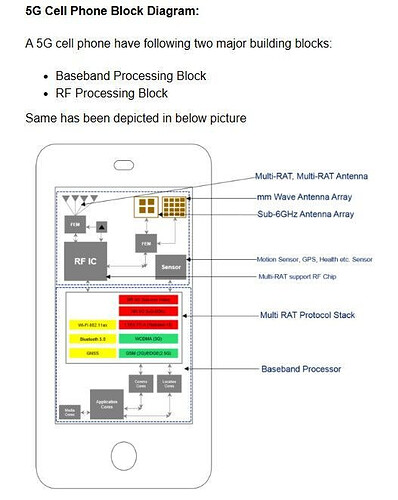5G Cell Phone Architecture
5G cell phones has to be designed to comply either 3GPP New Radio (NR) Release 15 and also need to support legacy radio access technologies . Intial, 5G cell phones will be support Non-Stand Alone (NSA) protocol stack.
Requirements for 5G Cell Phone
- Comply to 3GPP Release 15 – NSA
- Support for Legacy technologies GSM/EDGE, WCDMA, LTE/LTE-A
- Support for Beam-forming, multi-antenna
- Support for low frequency bands (< 1 GHz), mid frequency bands (Below 6 GHz) and high frequency band (Above 6 GHz)
- Support for Non-3GPP technologies like Wi-Fi, Bluetooth and NFC
- Support for GNSS/GPS for location tracking
- Support for different sensor like Proximity Sensor, Light sensor, Magnetometer,Gyroscope, Thermometer, Iris Scanner, Heart rate Monitor etc.
5G Cell Phone Block Diagram
A 5G cell phone have following two major building blocks:
- Baseband Processing Block
- RF Processing Block
Same has been depicted in below picture
Baseband Processing
A Baseband processing block is constitutes different cores (Application core, Multimedia core, communication core etc.). These core enables functioning for operating system, device drivers, interfacing with Mic, Camera, Screen etc. It also have baseband processor containing multi- RAT protocol stack software.
5G cell phone baseband software expected to support 5G NR in both frequency bands i.e. sub-6 GHz and mm wave bands. Along with this, protocol software need to support 4G LTE, 3G WCDMA and 2G GSM/EDGE. Software shall also includes protocol support for non-3GPP technologies like Wi-FI, Bluetooth and NFC for short range communication. Protocol software specific at physical layer , it need to support advance baseband signal processing algorithms to enable Massive MIMO, Beam forming and interference suppression features.
RF Processing
RF processing block is responsible to receive and transmit the baseband signals. As shown is above picture, this block is constitutes of a RF IC, front end module (FEM), LNA, Antennas Arrays and sensors.
RF IC enable co-existence for different radio access (Wi-FI, Cellular, GNSS etc) signals. 5G cell phone will have different antenna module to support wide range of frequency bands i.e. mm waves, sub-6 GHz bands and Low frequency bands.
RF section shall have some important sensors like Proximity Sensor,Light sensor, Barometer, Magnetometer, Accelerometer, Gyroscope, Thermometer,Iris Scanner, Heart rate Monitor, Pulse Monitor
